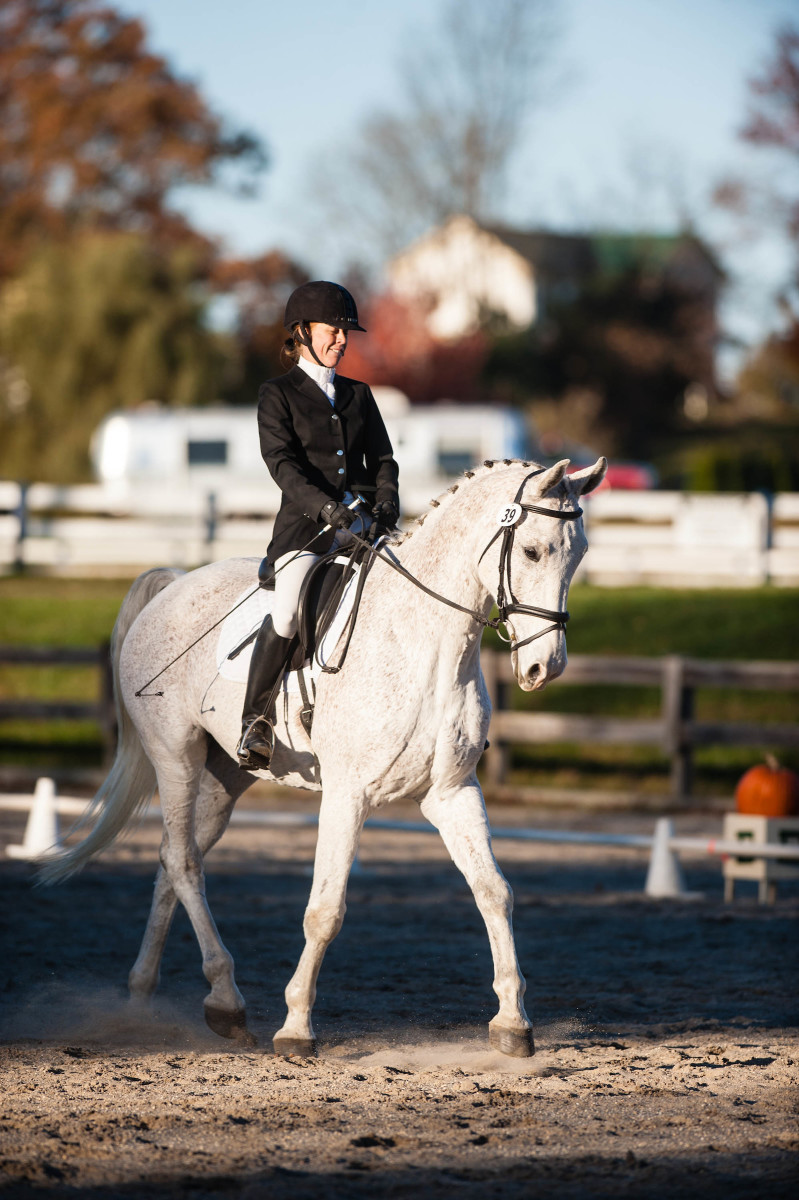Six months ago, most of us couldn’t have imagined taking dressage lessons long-distance, but now virtual teaching is commonplace. The same is true with virtual dressage shows. This is no surprise since virtual shows and instruction have helped fill the COVID-induced void in our dressage world.

We’ve also come to find that both virtual lessons and shows may not be merely a temporary replacement for the real thing. They have a useful place in our dressage lives, especially for those living in locations where shows and trainers aren’t just around the corner. Virtual fix-a-tests are a sort-of lesson/test-ride alternative that also works well.
Virtual lessons can have a similar feel to the real deal, especially if you’re used to using earphones, although the set-up can be a bit daunting at first for the technologically-challenged. Virtual shows are a different matter—they can be easier than attending a live show since there is no trailering or formal attire involved. The most complicated parts are finding a friend to film the test on a cell phone and then uploading the video.
Success in riding a virtual test versus a live test at a show, can be dependent on understanding the limitations of the medium, just as understanding showmanship can affect the color of your ribbon at a live show. Here are some of the “virtual showmanship” thoughts we’ve gathered over the past six months.
The viewpoint is determined by the camera (or the person holding the camera), not the judge’s eyes. This narrows the focus for the judge considerably, making the view two-dimensional rather than multi-dimensional. It flattens the effect. Thus, scores could be a tad lower than they would be in real life. You want to do everything you can to heighten the impact of your performance.

1. Hold the cell phone horizontally rather than vertically. This gives a better perspective of the horse in the space of the ring. If the phone is held vertically, the image tends to be smaller and the sense of the ring space is lost.
2. The photographer should use the zoom feature as best they can, but only so far. If the horse is at the A end of the ring, then zoom closer so the image and details become clearer. If the horse is nearer to C, then zoom away so that the entire horse can be seen, if possible. Practice this ahead of time and assess the test effort. Don’t overdo the zooming if the image becomes shaky. Check that the focus is clear.
3. The position at C can be problematic if filming in an indoor ring or with a fence rail in the way. The photographer should think about this ahead of time and, if possible, step back a bit or aside at times. In one very creative effort I saw, the photographer moved into the 20-meter circle at C when the horse was at that end of the ring, while staying focused on the horse the entire time, because there was no space at the end of the ring for her to stand.
4. Lighting makes a huge difference. The brighter the light aimed on the horse, the better you will look. Shooting in an indoor ring with good lighting works well because the lighting is consistent and there are no shadows. If shooting outdoors, consider the time of day, especially if the ring is only oriented in one direction. Ideally, the sun should be behind the photographer or behind the C end of the ring, not behind the horse or the A end of the ring. Shooting at mid-day or when the sky is overcast also can work well, especially if there are trees or buildings throwing a shadow on the ring that obscures the horse.
5. Dust is a bummer, just like it is at a live show. Can the ring be watered before you ride? Puddles won’t matter unless there’s mud, but dust will. Dry grass is worth a consideration if the soil provides secure footing.
6. A formal ring set-up isn’t necessary. If you don’t have a regular ring, you can use a few fence rails and soccer cones if need be. The bigger the cones, though, the easier it will be for the judge to appreciate your accuracy.
Virtual shows can be run by a wide variety of entities because they are easier to organize. One downside is that the score won’t be readily available right after the test. On the upside, when you get your score sheet, you’ll have the video to analyze what the judge is seeing for yourself. Virtual shows are also only “schooling shows” and aren’t recognized by governing organizations, although a local club might set up its own award program. Scores from virtual shows and live shows really aren’t equivalent because the conditions of the virtual shows can vary so widely.
Please note that the FEI has stated that any horse registered with the FEI, or any FEI-licensed official, may not take part in a virtual competition that includes placings or prizes, although virtual fix-a-tests and tests for “educational purposes” are okay. If they do, then they may not take part in an actual FEI show (a CDI) for six months. There is no such restriction by the USEF.

Margaret Freeman is a USEF “Senior” dressage judge from Tryon, North Carolina, and has been judging dressage shows for 30 years. She is a freelance writer/editor and has covered the equestrian events at seven Olympics for the Associated Press. She is Executive Secretary of the U.S. Dressage Federation. She’s also an experienced show organizer, is on the committee of the Youth Dressage Festival (NY) and was on the founding committees of CDCTA (VA) and Dressage at Devon (PA).











